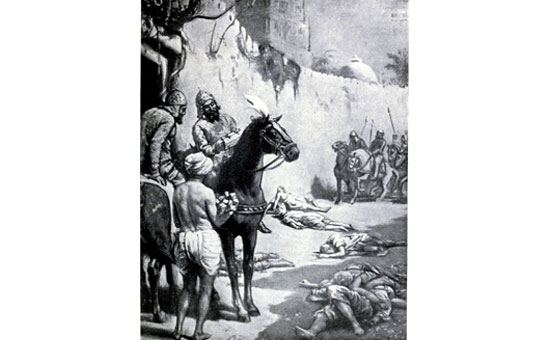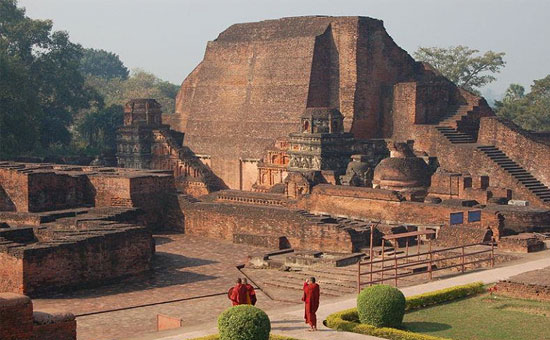- History books
tell us that the Vedas were not put to writing until the 19th Century. If so, why were some Vedic manuscripts found
in the 11th Century?
- When Chanakya
could hand-write Arthashastra 2,000 years ago, and Kalidasa wrote his epics
1,500 years ago, it seems highly unlikely that the most sacred texts of India
were never written until very recently.
To read article
in Tamil please click on PDF to
download file.
The Vedas are
the earliest known texts in the world. There
are Four Vedas, namely, The Rig, Yajur, Sama and Atharva (or Atharvana) Vedas. Our
tradition holds that Vedas are “Apaurusheya”, namely not authored by a human being. Even though we know that the Vedas are learned by the “karna parampara” (i.e. by listening, like one learns Indian Classical music), is it not intriguing that such ancient literature was not put to writing, and their dates not correctly known? Here, we are not referring to the first composition of Vedas, but to the first handwriting of the mantras that have been chanted over millennia.
The Vedas encode
astronomical planetary (grahas)
positions in numerous places, from which many dates can be inferred. Our traditions use that internal evidence to
put the date to tens of thousands of years back. The dates ascribed to Vedas by modern
historians fall between 2000 BCE to 1000 BCE (1,2). This discrepancy is because most Modern Historians (such as
Singh and Kulke whose books are referred to in this article) neither have any knowledge
of Vedas nor have they developed a scientific method to corroborate traditional
knowledge. Instead their writings
heavily depended on the translations of western writers which are faulty in
nature.
We are also told
by the modern historians, that Hindus did not put the Vedas to writing and that
they were transmitted orally through recitation and memorization. That it is only in 19th century
that they were put to writing as texts.
But is it not puzzling
why such great text as the Vedas was not put to writing? And from when do we
start getting written literature? What were the materials used for writing? In
that case, how is it that some 11th century Vedic manuscripts are
found? (1,2) At the same time, what to make out of the fact that the ‘Indus script’ is the most ancient Indian script and that it is not deciphered?(2)
Answers to these
questions will enable us to understand the issues connected with the writing of
the Vedas.
Early
communication of mankind was through sounds which gradually developed into
verbal communication. In course of time the written word appeared. While in
oral transmission of knowledge proximity of receivers is necessary, writing
marked a new possibility of storing and transmitting knowledge to distant
seekers as well. In Hindu tradition, the Guru-sishya parampara system of
imparting knowledge helped the sishyas to learn in both the ways i.e. oral and
written.
To preserve the
Vedas, our Rishis evolved a very profound system of metres, svaras, grammar and
phonetics. These are available to us as
the elaborate Vedaangas. The Chandas is
a science that deals with the metrical compositions of verses. Shikshaa deals with phonetics and
pronunciation. Vyaakaranam involves grammar and linguistic analysis. Nirukta
is the science of interpretation of words and their contexts, especially words
that are not in common use. This is a highly
scientific way to retain a vast amount of literature through memorization, and
transmit the Vedas from generation to generation without loss. Is it possible to believe that so much
science was developed without the act of writing?
The Vedas, which addresses the four human “purushaarthas” – Dharma, Artha, Kaama and Moksha - form the bedrock of Sanaatana Dharma. In other words, it addresses human life in its entirety and beyond. It has provided the inspiration for scriptures in all regional languages like Tirukkural in Tamil Nadu and Adi Granth in Punjab! Can such eternal and advanced literature be produced by a non-writing culture as the western writers want us to believe?
The other corpus
of literature called as the Puranas is also available in manuscripts. The Puranic
literature is very vast. The dates assigned to Puranas range from 7th
century BCE to 4th century CE. This is a dating built by foreign writers.
According to tradition the dates are much older and as old as the Vedas itself
because there are references to Itihasas and Puranas in Atharva Veda and some Upanishads.
There are Eighteen Mahapuranas and Eighteen Upapuranas. According to western
scholars again they were collected first by Veda Vyasa and then again for a second
time between 4th and seventh century CE, i.e. during the Gupta
period. Indian Historians accepted these dates uncritically without consulting
our own Vedic Scholars and Swamis.
Again,
according to western scholars, till 19th century, the Puranas were
not written and were only transmitted orally. But the Puranas are available in
many regional versions which makes us believe they must have been written much
earlier. Even if we agree that they were collected during Gupta rule, we have
all the literature of Gupta time like that of Kalidasa available in manuscripts!
If Chanakya could write Arthashastra
2,000 years ago, Kalidasa could write his epic masterpieces 1,500 years ago,
and Bhaskaracharya wrote Līlāvatī, a 13 chapter volume on mathematics 850 years
ago, why would the Puranas not be put to writing in a highly literate society until
the 19th century?
Another point is that Veda Vyasa is stated in the Puranas as the compiler of the Puranas. The story of writing Mahabharata by Lord Ganesh while Vyasa Muni was dictating is well known to all of us. To keep pace with writing of Ganesh ji, Ved Vyasji adopting certain tricks as stated in the Mahabharata. When the Ramayana and the Mahabharata were written how is it that Puranas were not written in early times? Shouldn’t our research start with the assumption that they must have been written?
 Which Indian does not know of Bhagavaan Ganesha writing the Vedas.
Which Indian does not know of Bhagavaan Ganesha writing the Vedas.When we recall
the story of Matsya Avatar of Lord Vishnu, we get an incidence of the Vedas
being stolen by the demon Somaka. This would suggest that Vedas were put to
writing, because it is not possible to steal an oral asset. Additionally, the
Matsya Purana is one of the earliest Puranas. The date ascribed is 1,000 BCE to
4th Century CE. All these dates are questioned by traditional
scholars. However, there is an argument that the Murthy Pooja in India is
stated to have been associated with the stories of Vishnu Avataras and the Puranas.
And Murti Pooja resulted in construction of Temples. The popular Murties of
Brahma and Saraswati are seen holding Vedas in the form of palm leaf books. This
should indicate that the Vedas were available in written form much earlier than
what we are told.
 Vishnu as Matsya Avatara returning the Vedas to Brahma. Brahma and Saraswati holding the Vedas.
Vishnu as Matsya Avatara returning the Vedas to Brahma. Brahma and Saraswati holding the Vedas.
Ancient Hindus
used Tala patra (palm leaves) for
writing. They were also written on Bhoj patra, the bark of a tree found in the
Himalayas. They were using charcoal powder mixed with vegetable juice to smear
on the engraved letters on the leaves. It was a lasting writing technique. So
there were manuscripts in ancient past.
It is from the
time of Muslim invasions that we start losing our written literature. There
were several instances where the Muslims burnt libraries, killed temple priests
and the Achaaryaas of gurukulas and their ashrams, temples and belongings
destroyed. We have the infamous case of Nalanda Library being burnt by Sabuktagin
Bakhtiyar Khilji in the year 1193.
Even a thousand
years ago, so vast was the library that it took some three months for the whole
library to completely burn down! We can imagine how much of literature is lost
in just two University. During his raids across North Indian plains, Bakhtiyar Khilji
destroyed the Vikramshila University also, massacring many Buddhist and Brahmin
scholars (3). Several catastrophic invasions
have caused a lot of damage to our heritage.
We must salute the tradition of the memorization that we are able to
have the Vedas to this day.
 Bakhtiyar Khilji’s massacre of Buddhist monks and his burning of Nalanda University (source Hutchison’s Story of Nations).
Bakhtiyar Khilji’s massacre of Buddhist monks and his burning of Nalanda University (source Hutchison’s Story of Nations). Remains of Nalanda University seen today.
Remains of Nalanda University seen today.
In summary, it is not plausible that the Vedas were not written until very recently. Rather, the written manuscripts were lost by the time British arrived in India. We refute the currently proposed dates of the Vedas of 3000-4000 years ago. We need to further probe into the most accurate dating of Vedas and the importance of these seminal texts in constructing Bharat’s history to bring out the antiquity of Hindu Civilization. For example, many Buddhists texts that were lost in India are found in China. Even several portions of the Vedas as we know today were reconstructed by tracking down numerous Vedic pundits in different parts of India, and recording from their memory.
Some traditional
families still preserve the very ancient leaf-written manuscripts. Do they
contain as yet undiscovered truths about us?
Traditional Sannyaasis, Vedic Pundits, Ashrams and Vedic Institutions
have a big role to play in this journey.
References
1. Hermann Kulke
and Dietmar Rothermund, A History of India, Croom Helm, 5e, 2011.
2. Upinder
Singh, A History of Ancient and Early Medieval India – From the Stone
Age to the 12th Century, Pearson Education India, 2009.
3. Sanjeev
Sanyal, Land of seven rivers: History of India's Geography, Penguin
Books Limited, 2012.
4.ByUnknown-https://archive.org/details/hutchinsonsstory00londuoft, Public Domain, https://commons.wikimedia.org/w/index.php?curid=39273227
5. “EU keen to associate with upcoming Nalanda University in Bihar”, India Today, October
25, 2013.
Authors are Prof. Lakshmi Inukonda & Dr. Jayakumar S. Ammangudi.
About co-author - Dr. Lakshmi Inukonda is Retired
Professor of History from Osmania University.
She received M.Phil. and Ph.D. from Jawaharlal Nehru University, New
Delhi. She has published articles in
prestigious Journals like Indian Historical review, Indian History congress and
edited books of prominent scholars. Presently Prof. Lakshmi is learning the
Sanskrit texts to retrieve real history of our past as a part of unlearning the
previous constructs.